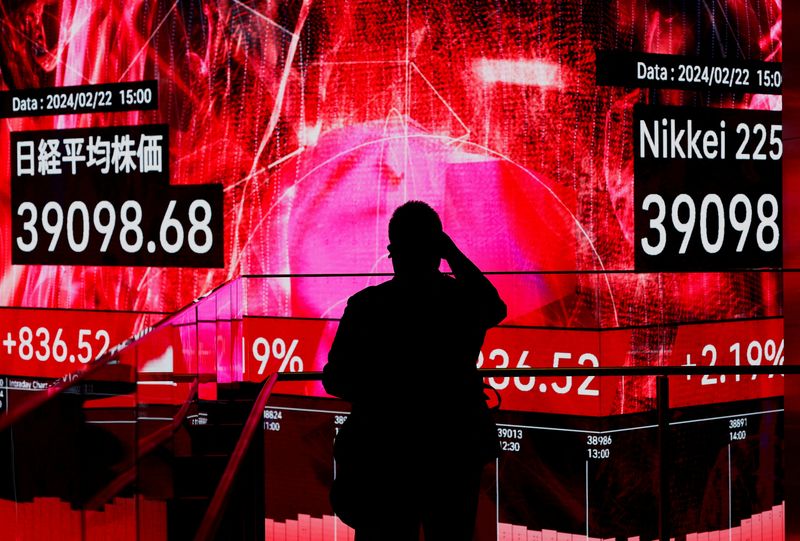By Jamie McGeever
(Reuters) – A look at the day ahead in Asian markets.
An Asian economic calendar on Friday overflowing with top-tier indicators awaits investors, who look set to close out the week and the month on a downbeat note as worries grow over the strength of the U.S. and global economies.
Investors often cheer ‘bad news’ on the U.S. economy by bidding up risk assets on the view that the Fed will be forced to ease policy. Equally, ‘good news’ often drags stocks and bonds lower because rates may have to stay higher for longer.
Investors’ reaction to revised U.S. GDP figures on Thursday followed neither play book – bad news was bad news. Slower GDP growth in Q1 pushed stocks, the dollar and bond yields lower, and relatively dovish comments from New York Fed president John Williams failed to provide much comfort.
The MSCI World, , MSCI emerging market and 225 indexes are all poised for their second weekly loss in a row. Rising bond yields, and now U.S. growth concerns, are taking their toll.
And could the U.S. tech fairy tale be starting to fade too?
Financial conditions certainly seem to be biting. According to Goldman Sachs, emerging market, Chinese and global financial conditions are the tightest in a month. Little wonder, perhaps, that investors are taking some chips off the table as the month end approaches.
It may be month-end on Friday, but there will be no rest for Asian markets. Not if the economic calendar is anything to go by.
China’s official purchasing managers’ index reports for May, a raft of top-tier indicators from Japan including retail sales, industrial production and Tokyo inflation, and first quarter GDP from India and Taiwan are all on tap.
China’s PMIs are expected to show that manufacturing activity in May grew at a similar pace to the previous month when it barely managed to stay expansionary, reinforcing the fragile nature of the recovery in the world’s No.2 economy.
China’s economy blew past expectations to post growth of 5.3% in the first quarter, and a string of April indicators including factory output, trade and consumer prices suggest it has successfully navigated some near-term downside risks.
But the crisis-hit property sector remains a major drag, deflationary pressures persist, and capital is just as liable to be flowing out of the country than in.
Core inflation in Japan’s capital, meanwhile, is expected to have picked up in May to 1.9% from a two-year low of 1.6% in April, and India’s economy likely grew at a 6.5% rate in the January-March quarter – its slowest pace in a year – due to weak demand.
Here are key developments that could provide more direction to markets on Friday:
– China official PMIs (May)

– Tokyo inflation (May)
– India GDP (Q1)
